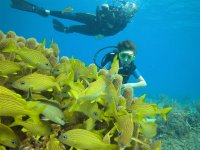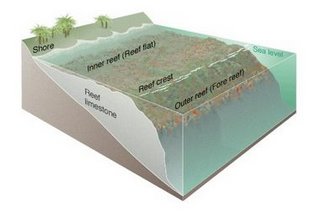Marine Parks and Reserves
 Kenya is well known for its safari parks and visitors are lured from all over the world to catch a glimpse of the 'big five'. But, less well known, are Kenya's marine parks and reserves, which play host to an incredible array of exotic fish, coral reefs and marine life.
Kenya is well known for its safari parks and visitors are lured from all over the world to catch a glimpse of the 'big five'. But, less well known, are Kenya's marine parks and reserves, which play host to an incredible array of exotic fish, coral reefs and marine life. Mombasa Marine National Park & Reserve
Malindi Marine National Park & Reserve
Kisite Marine Park & Mpunguti Reserve
Kiunga Marine National Reserve
Watamu National Park
 Coral reefs, mangrove swamps and warm waters are vital ingredients for achieving and maintaining a fragile ecological balance which, in turn, gives rise to a rich and diverse marine life. The reef, protected by the Kenya Wildlife Service (KWS), provides an essential food source for marine life and attracts myriad and abundant species.
Coral reefs, mangrove swamps and warm waters are vital ingredients for achieving and maintaining a fragile ecological balance which, in turn, gives rise to a rich and diverse marine life. The reef, protected by the Kenya Wildlife Service (KWS), provides an essential food source for marine life and attracts myriad and abundant species. Kenya's fringing coral reef traverses the shoreline almost uninterrupted. It is located from anywhere between half a kilometre to 2km off-shore. Eco-tourists, scuba divers and snorkellers alike contribute by visiting Kenya's marine parks and reserves.
Mombasa Marine National Park & Reserve, Kenya
Mombasa, a coral island, has a beautiful coral reef, ranging from vibrantly coloured hanging reefs to large corals.
Location: Trips take place within the conservation area, north of Mombasa, from Mtwapa Creek to Likoni.
Size: The park is 10 km2; the reserve is 200 km2.
Depths: 30ft to 1000ft.
Marine species: Large, pelagic (fish which swim rather than rest on the ocean bed) game fish, such as barracuda, tropical coral fish, red and yellow snapper, and similarly coloured corals, mangroves, crabs, sea stars, urchins, sea cucumbers and jelly fish.
Activities: Scuba diving, snorkelling, a variety of water sports, swimming, wildlife viewing. Those unwilling to get wet may observe marine life from a glass-bottom boat.
Malindi Marine National Park & Reserve, Kenya
A stunning assortment of fringing and patch reefs, coral gardens, lagoons and marine life can be found here. The North Reef, the main attraction, is separated from the shoreline by the Barracuda Channel. The channel is deep, but scuba divers can explore the rich seaweed, shell and spider conch on its sandy bed. Low tide exposes shallow pools and seaweed along the pretty coral sand beach.
North Reef
It lies parallel to the shore for more than half the length of the park. Low tide exposes most of the reef, revealing a rather bland surface of old coral and seaweed. However, just beyond the sand bank, at the north end of the reef (shoreward), is a large sandy inlet where fish become stranded when the tide recedes. Crabs, star fish and sea anemone hide under rocks. But even from the edge it is possible to observe trapped moorish idol, parrotfish, octopus and eel.
At the opposite end of the north reef is another clear, shallow inlet, called the Coral Gardens. This is home to the spider conch and shoals of pelagic fish. The southern tip of the North Reef has many varieties of coral, including madrepores, finger, potato and mushroom. These corals attract large and varied shoals of coral fish.
But the most splendid show lies a short distance from the Coral Gardens. On the outer edge of this coral bank, where depths reach approximately 40ft, silvery swathes of pelagic fish - barracuda, cod, unicorn, kingfish, kole-kole - dart in and out of the deep blue depths. The striking blue surgeonfish is a common sight among the staghorn, finger and fan coral. Turtles, though shy, are often seen feeding on the lower slopes. The occasional reef shark is encountered as well as rays and lobsters which feed on the bottom.
Location: Kenya north coast, south of Malindi. It stretches from Leopard Point (south) for a mile south-west of Sand Island. It then extends northwards for a mile along Stork Passage to beyond the tip of the North Reef and from there back to the beach at Chanoni Point.
Size: The park is 6km2; the reserve is 213km2.
Marine species: Dolphins, turtles, demoiselles, butterflyfish, moorish idol, sweetlips, cleaner wrasse, sergeant major. Anemonefish or clownfish are resistant to the stinging tentacles of sea anemones and claim this habitat for protection from predators. Scuba divers and snorkellers may find even richer marine life, such as the spiny lobster or the scorpion fish, under overhanging rock or coral.
Corals include; potato coral, staghorn, finger, brain, madrepore, mushroom. Less common is the fungus coral, which clearly resembles the flat, fan-shaped fungus that grows around the base of tree trunks.
Activities: Scuba diving, snorkelling, swimming, wildlife viewing - also available from the dry confines of a glass-bottom boat.
Kisite Marine Park and Mpunguti Marine Reserve, Kenya
Comprises four small islands surrounded by coral reef and abundant fish and marine species. Kisite, a small coral island, lies 8km offshore in the marine park. Portions of its coral banks are exposed at low tide. The three other coral islets - Mpunguti ya Juu, Mpunguti ya Chini and Liwe la Jahazi - are located closer to Wasini Island.
Kisite Marine Park and Mpunguti Marine Reserve has been the centre of discussion for European marine biologists because of its increasing number of new species of fish and coral. There are approximately 250 varieties of fish and more than 40 documented coral species.
A dhow transports visitors to the islands of Mpunguti and Kisite. It is a favourite haunt of scuba divers and snorkellers because the crystalline, shallow waters clearly exhibit the large varieties of marine life.
Location: Kenya south coast, 75 miles south of Mombasa, off Shimoni and south of Wasini Island, Kwale District, near the border with Tanzania.
Size: Kisite Park is 11km2; Mpunguti Reserve is 28 Km2.
Marine species: Large numbers of pelagic fish, parrot, red and yellow tuna, butterfly, snapper, rock cod, angel and manta ray. Turtles, dolphins and reef sharks may also be seen.
Corals include staghorn, brain, lilac-blue, mushroom, and lavender.
Activities: Scuba diving, snorkelling, swimming, wildlife viewing. Those keen on deep sea fishing can travel further south to the Pemba Channel to catch large barracudas and kingfish.
Kiunga Marine National Reserve
Part of Lamu Archipelago, these 50 or so islands and coral reefs are composed of eroded coral. They lie approximately 2km offshore and inshore of the fringing reef and about 60km parallel to the coastline, adjacent to Dodori and Boni National Reserves. Migratory seabirds nest on the small outer islands and thorny vegetation - creepers, grass, and aloe - grow on the larger and more sheltered inner islands. The reserve protects and maintains the coral reef, sea grass meadows, mangrove forest, sea turtles, dugongs and marine species.
Location: Kenya north coast, in the Lamu Archipelago.
Size: The islands vary in size, from a few hundred square metres to more than 1km2.
Marine life: Sea turtle, leatherback, dugong, olive ridley, reef fish, lobster, crab, sea urchin, sea star, coral reef.
Activities: Scuba diving, snorkelling, swimming, wildlife viewing,
wind surfing, water skiing.
Watamu Marine Park, Kenya
The park, which incorporates Mida Creek mangrove forest, consists of sandy beaches, coral reefs, platforms and islets. It is enclosed by the Malindi Marine National Reserve. The water is clear and shallow with a bed of coral, weed and sand. The small coral gardens and fringing reefs lie parallel to the shore, but are not exposed during low tide. The north end of the gardens has some interesting displays of coral, while it tends to grow in bulk at the edge of the channel. Mida Creek is a large, almost land-locked expanse of saline water and mangrove forest. The western tip of Mida Creek is part of the Arabuko Sokoke Forest Reserve.
Location: Kenya north coast, 14 miles south of Malindi, from the mouth of the Mida Creek, continuing north to Turtle Bay.
Marine species: Clown fish, wrasse, octopus and sea anemones.
Corals include; madrepores, brain, staghorn and finger.
Activities: Scuba diving, snorkelling, swimming, wildlife viewing.
Home | Climate | Travel preparations | Visa | Coast Province | Kenyan coast | Getting about | Beach accommodation | Diani Beach wildlife | Marine Parks | Life in Kenya | Maasai | Safaris | Safari news | Safari flight | Kenya safari wildlife | Game Reserves | Maps | Health | Safety | Wildlife webcam | Kenya Media |

0 Comments:
Have you been to Kenya? Is there a wildlife park or lodge that you would recommend? Write a review here about your 'big five' safari holiday and tell others about your experience - good or bad. Perhaps you know of an excellent budget campsite - or a luxury lodge that should be avoided! Otherwise, feel free to post a question. Let's share our Kenya safari wildlife experiences...Post a Comment
<< Home